Norway September 4-12 2018
I crossed a large fjord to enter Norway in the early afternoon. This was the first border in Schengen that checked my documents – passport and car registration – and asked where I was staying and how long I was going to be in the country. She even looked in the van.
Day 1
SOUTH OF OSLO
Fredriksten Fortress. At Halden, 12kms east just after the border, this large fort was built in 1640 to protect the new border with Sweden after the loss of Bohus and Bahuden in 1658. Sweden attacked it six times, most notably in 1716 and 1718 (the Swedish King Karl XII was killed in this battle), all unsuccessfully. In August 1814, Norway had to fight for a new constitution and Fredriksten was bombarded again but failed again to gain the castle (the Norwegians really knew how to build impregnable fortresses). It was restored in 1905 and opened to the public.
Drive up and park in a park with an opera house and restaurant on top. Enter the fort itself on the east side of the hill to see a museum (closed for the season) and several layers of battlements protecting the buildings. There are great views to the west.
FREDRIKSTAD
In Østfold county, Norway, the city was founded in 1567 by King Frederick II. The city straddles the river Glomma where it meets the Skagerrak. Along with neighboring Sarpsborg, Fredrikstad forms the fifth largest city in Norway: Fredrikstad/Sarpsborg with a total population of 136,117 with 80,977 in Fredrikstad and 55,140 in Sarpsborg. Fredrikstad was built at the mouth of Glomma as a replacement after Sarpsborg (15 kilometres (9 miles) upstream) was burnt down by the Swedish Army in the 1500s. Some of the citizens stayed behind and rebuilt their old town at its original site and got their city status back in 1839. The city centre is on the west bank of the Glomma, while the old town on the east bank is Northern Europe’s best preserved fortified town.
Fredrikstad used to have a large sawmill industry and was an important harbour for timber export, then later on shipbuilding, until the main yard was closed in 1988. The main industries are currently various chemical plants and other light industry.
Fredrikstad Fortress (Kongsten Fort). This small fort built in 1685 has high battlements protecting some wonderful stone buildings. It added extra strength to the main fort to the east, saw its only action when the Swedes attacked it in 1814 and the military used it until 1870.

The real Fredrikstad Fortress – Gamlebyen, the Old Town.
Kongsten Fortress – the other fort in Fredrikstad
Old Town Model Railway Museum. This model railway exhibition in a detailed landscape consists of 30 computer controlled train sets is well worth a visit. The trains snake through several rooms and run at various levels across bridges and through tunnels. Good sceneries, rural places and city centres with people, animals, houses and cars. All In scale 1:87. Great for kids. Middling standard for model railroading – it is built with sectional track. There are loads of building structures – all plastic kits. No weathering of buildings or rolling stock. Rolling stock is plastic ready to run. There is also a model of the Gamlebyen Fortress, a fortified town. NOK50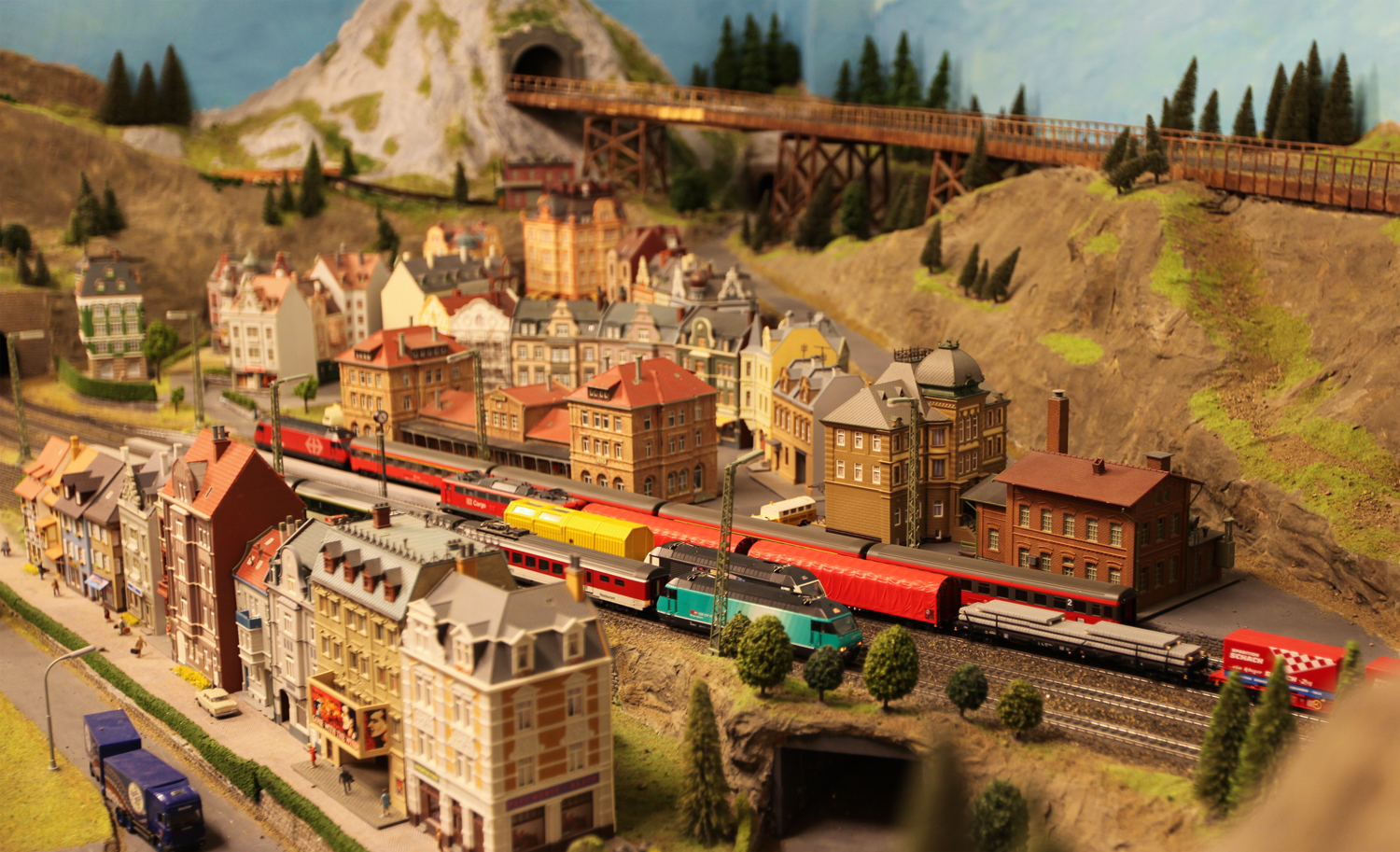

Fredrikstad Museum. Next to the church, this city museum is housed in a lovely 1775 brick building, the Tøihuset , the old military magazine in Old Fredrikstad. The museum shows the history of the city and region spanning from the 1500s until the present day. Very little English. Hours 12-4.
Borgasyssel Museum. It is located Sarpsborg, Østfold District, 10kms east of Fredrikstad, It was founded in 1921 and documents Østfold’s cultural history from the Middle Ages. The museum was named after Borgarsysla, the Old Norse name of Østfold county. The open-air collection includes about twenty historic buildings. It is situated at the site of the ruins of the Medieval St. Nikolas Church which was built during the reign of King Øvstein (1103-1123). Olav Chapel was built at Borgarsyssel Museum as an exhibition hall for the Olavsjubileet in 1930. Since 1947, Borgarsyssel Museum has been the main county museum of Østfold, part of Østfold Museum system, that organizes all museums in the county.


EAST OF OSLO
Day 4
I decided to make a big loop west from Drammen and see the following sites. It ended up being a long drive about, but through wonderful rural scenery – low hills, a mixed forest of pine, spruce and birch, lakes, reservoirs and farms. The scenery could easily be mistaken for the West Kootenay of British Columbia.
Driving Norway roads could drive one insane. Every farm has a speed restriction – 90 is the maximum and 50-70 more common. The traffic is always going less than the limit and Norwegian drivers are timid and don’t pass. They are even more polite than Canadians, which is hard to believe.
Blaafarvevæket. Near Amot, about 43kms NW of Drammen, this cobalt mine and works turned museum offers mine tours. The Royal Cobalt Works were established in 1776 to extract cobalt for the cobalt blue colour used in most of the world’s porcelain and glass. Cobalt was the only colour that tolerated the very high temperatures required in porcelain production – have you ever wondered why all old porcelain is blue? The company was the biggest in Norway at the time producing 80% of global cobalt. 2000 men worked in the mines and works during the height of production from 1802-48. The works closed in 1848 due to bankruptcy during an economic downtown and with the invention of ultramarine blue. Production was moved to Saxony Germany and the mines closed in 1893. The works were 8kms from the mines to take advantage of the 39m Haugfoss Waterfall as waterpower ran all the production machinery.
Producing cobalt powder was a labourious process. Stamp mills crushed the cobalt ore. The lighter stone was washed out and the sand produced was roasted to remove the sulfur and arsenic. Quartz stones were burned at 600°C to temper the crystal and this was likewise crushed in stamp mills. Potash was added to the cobalt and quartz sand and this was smelted at 2000°C in 2 huge furnaces to from a blue molten glass mixture, that was cooled into a hard mass and ground with quartz mill stones to produce a glass sand. This was then fed into a succession of sedimentation ponds taking a month for the heavier cobalt to separate out. 30 different shades of cobalt were produced with the finer, darker cobalt the most valuable. It was then packed in wood barrels and shipped from Drammen to Great Britain, Denmark and Amsterdam (the Dutch with a monopoly in the Far East then shipped it to China and Japan). The entire process is well described in several buildings and displays. A shop had a wonderful selection of brilliant blue glass and porcelain.
There are two mine tours 8kms up the hill from the mill works. Both mines are at a constant temperature of 4°C so dress warmly. The Historical Mine Tour passes through tunnels crossing a suspension bridge and glass floor. It is offered at 12 and 2pm (and 4pm in peak season) from mid-May to the 3rd week of September. NOK195. The Mine Safari Tour goes through a 1.5km long network of beautiful tunnels, shafts and halls as large as cathedrals with an 80m-elevation change. It is offered only on Sundays and Wednesdays at 1pm from the end of May to the end of August. NOK310


Vatnås Kirke. I passed this lovely church and wished it had been open. Originally built in the Catholic period, it was beautifully decorated and restored. The 1250 crucifix is in the National Museum in Copenhagen but a replica is here.
Flesberg Stave Church. In the NM “religious temples” series, I regretted coming so far out of my way to see it. It is open only on Sundays and the outside was an ordinary fairly modern (1800s) building with black siding, white trim and a red steeple. A local woman told me the interior has elements of the original stave church from 1200 and most of this was added after the Reformation of the 1530s. The most interesting was the long fence of large flat slabs of rock around the church and big graveyard. Iron rings in the stone were used to tie up horses.
Heddal Stave Church. See the exhibition in the basement of the café before visiting the church. It shows mostly photos of brilliant wood carving from all the stave churches in the district. Most of these were tiny and after the Reformation proved to be too small to hold the congregations, were demolished and replaced with stone churches. Only Heddal remains as it was a much larger building. Unfortunately there is no information board about this church and everything here is from the guide, a young guy who normally collects tickets only. I would not bother buying the NOK80 ticket as little of the interior is original.
The exterior is the highlight with 3 steeples and wonderful gingerbread shingles. The doorframe had great carved wood.

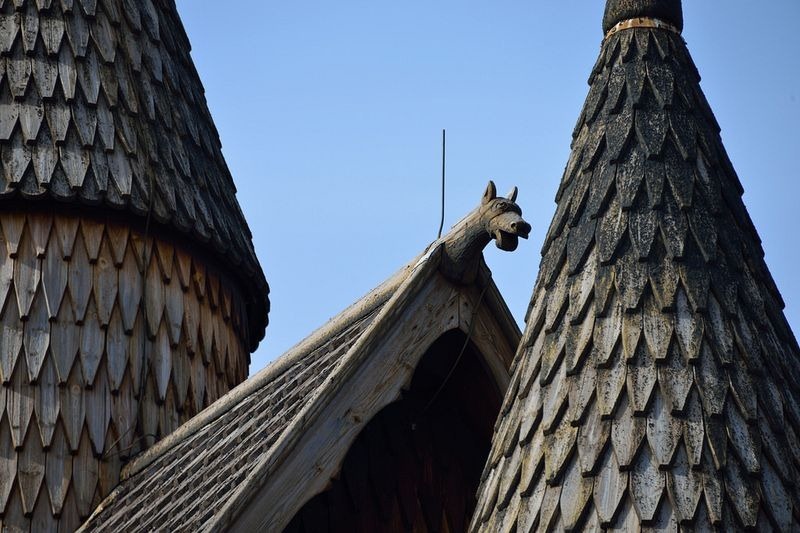
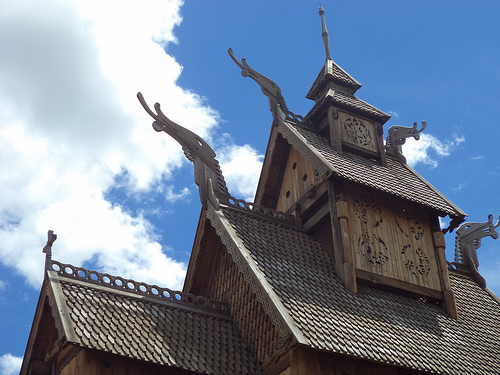
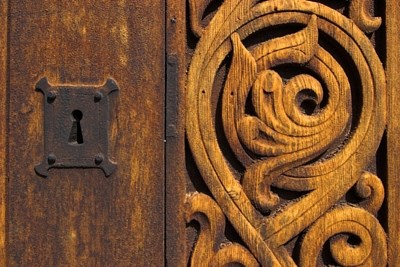
Little of the actual 1200 interior exists. After the Reformation, the original Catholic bible stories painted on the walls were over painted with a rose configuration (as the sermon was in Latin and no one but the priest understood that, painted bible stories were necessary to keep the congregation interested). Only tiny remnants of the original can be seen. The bishop’s chair is the only original thing here. The original crucifix is in a museum in Oslo, the font and altar are from the 1600s and the bench is a recent replica. In 1850, all the wonderful painted ceiling and galleries were removed as was the huge carved, central stave post, pews were put in and a chandelier was hung as the richer folks could read the Danish bibles and needed light. In 1950, there was a movement to restore it to its 1200 appearance but that has never happened.
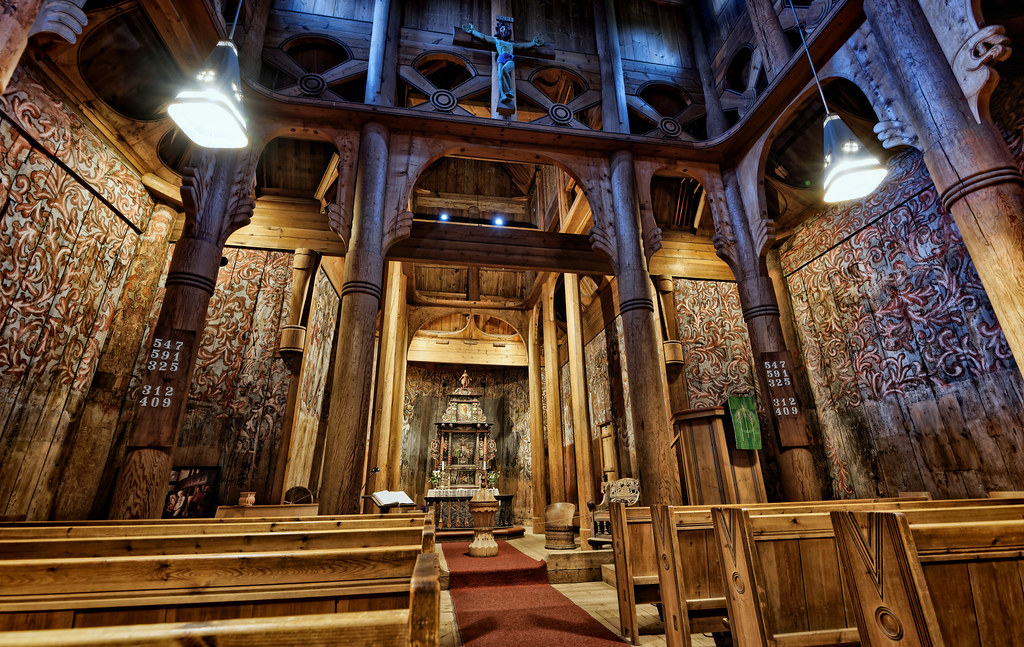


Rjukan / Notodden Industrial Heritage Site. This became UNESCO World Heritage Site listed in 2015 – I have never seen a more poorly organized WHS. Rjukan was a long ways north but Notodden was only 6kms from the Heddal Stave Church. The town is festooned with green UNESCO banners on many light posts but not one sign to find anything – I tried to locate the visitor’s centre and almost gave up after an hour of driving around. There is a large industrial site by the water but all the buildings were in active use although there is some nice architecture.
I was so pissed by the time I arrived at the centre (even then there was nothing that said “Notodden Industrial Heritage Site”, only Tinfos that I still have no understanding what that is), I gave a long rant and refused to pay the NOK100 ticket price to see the museum. I had a quick look at the exhibits and left with little understanding of what Notodden was all about, but guessed that maybe it was something to do with saltpeter, fertilizer and some sort of smelter. It was so awful I would have been really upset if I had paid to see it. The following is from Wikipedia and their brochure.
Ryukan-Notodden is based on the invention of the industrial production of fertilizer for agriculture, using hydropower. Kristian Birkland (1867-1917) invented a method for extracting nitrogen (needed to produce fertilizers) from air using a light arc furnace that split the nitrogen molecule at 3,000°C. A huge amount of electricity was needed. Norsk Hydro was founded in 1905, and industrial development began in the Eastern Telemark region, previously an underdeveloped and underpopulated agricultural area. To produce fertilizers, it was essential to build factories, power stations, infrastructure for workers, as well as facilities for exporting the production. The fertilizers, artificial saltpetre, eventually surpassed the Chilean naturally mined saltpeter, at the time the most widely used fertilizer.
At the beginning of construction, in 1907, the power was provided by the Svelgfoss Hydroelectric Power Station, which at the time was the largest in Europe and the second largest in the world. The station is still in operation. Subsequently, two more stations were built. Vemork, built on a waterfall near Rjukan, in 1911 was the largest power station in the world. A plant producing heavy water and most famous for the 1943 sabotage events (Operation Gunnerside) was built nearby. The original building of the station has been destroyed, but the station is in operation. Another power plant, Såheim Hydroelectric Power Station, started operation in Rjukan in 1915. The building survived but the station operates elsewhere.
A 93km railway was built from Notodden to Ryukan where an entire urban community was constructed. Using the existing Telemark Canal provided the transportation to the port of Skein from where it was shipped.
One of the 36 towers of the saltpetre factory’s tower house, which was in operation between 1911 and the 1980s, has been conserved and is protected as a cultural monument. In 1925, 80% of all apartments in Rjukan (1230 in total) were controlled by the Norsk Hydro. Red brick apartment buildings dominated, others were houses with individual gardens.
